The redefinition of the Araçuaí Belt to Araçuaí Orogen (Pedrosa-Soares and Wiedemann-Leonardos, 2000; Pedrosa-Soares et al., 2001a) is related to the correlation of the Araçuaí Belt with its African counterpart, the West Congo Belt, and to the southern limit of the São Francisco Craton. Before the opening of the South Atlantic, during the Mesozoic, these two belts formed a single Brasiliano-Pan-African orogen: the Araçuaí-West Congo Orogen (Figure 2 and 4). After that ocean opening, the Araçuaí Belt inherited more than two thirds of this orogen and since this paper is only concerned with the Brazilian part, the name is simplified to Araçuaí Orogen.
Figure 4. Geologic map of the Araçuaí Orogen

Geologic map of the Araçuaí Orogen (modified from Pedrosa Soares et al., 2001 and Lima et al., 2002).
Cenozoic covers. Cambrian:
G5 Suite (ca. 520-490 Ma);
G4 Suite (ca. 525-500 Ma). Cambrian/Neoproterozoic:
Salinas Formation. Neoproterozoic:
G2 (ca. 585-560 Ma) and G3 suites;
Paragneiss Complex;
G1 Suite (ca. 630-585 Ma);
Cratonic covers;
Capelinha Formation;
Ribeirão da Folha Formation (RF; u indicates tectonic slices of ultramafic rocks) and Dom Silvério Group (DS);
Rio Doce Group;
Salto da Divisa Granite (ca. 880 Ma);
Proximal units of the Macaúbas Group.
Pre-Neoproterozoic: e- Espinhaço Supergroup, a- anorogenic granite, jf- Juiz de Fora Complex, i- Itabuna Complex, m- Minas Supergroup, g- greenstone belt, gc- gneissic complex;
Tectonic transport;
Metamorphic polarity. A-B, location of the NW-SE section shown in Figure 5.
The present overview is based on the following publications: Pedrosa-Soares and Wiedemann-Leonardos (2000), Aracema et al. (2000), Martins-Neto et al. (2001), Pedrosa-Soares et al. (2001a,b, 2003a), Tack et al. (2001), Lima et al. (2002), Silva et al. (2000b), Wiedemann et al. (2002), Alkmim et al. (2003), Martins et al. (2004), Noce et al. (2004), and references therein. To improve the flow of the text below, citation of references is avoided.
The Araçuaí Orogen is located between the São Francisco Craton to the west and the Atlantic coast to the east (Figure 2 and 4). The northern limit, close to parallel 15 S, is also with the São Francisco Craton. The southern limit, at parallel 21 S, is marked by the deflection of the structural trend from NNE, in the north, to NE in the Ribeira Orogen.
The main tectonic subdivisions of the Araçuaí Orogen are the external domain to the west, characterized as a fold-and-thrust belt; the internal domain, which is the metamorphic core of the orogen with widespread orogenic magmatism; and the northern inflection that contains segments of both these domains, but with particular tectonic features.
The N-S trending fold-and-thrust belt of the external tectonic domain, adjacent to the São Francisco Craton, is characterized by tectonic transport to the west, metamorphism of greenschist to low amphibolite facies and absence of orogenic magmatism.
The internal tectonic domain, of higher metamorphic grade, is dominated by granitic rocks generated at several stages of the Brasiliano Orogeny. This domain includes the suture zone with remnants of ocean floor and a calc-alkaline magmatic arc. The metamorphic core with granulite facies rocks is preserved south of parallel 19 S. North of this parallel is an extensive zone of widespread syn- to post-collisional anatexis with many foliated and non-foliated S-type granites. In the western part of this domain, tectonic transport to the southwest is dominant, but transport indicators to the east are found in the eastern part.
The northern inflection zone is characterized by the curvature of the entire orogen, including its external and internal domains, to an E-W direction. Here the metamorphism of the Neoproterozoic sequences increases from greenschist facies in the north to high amphibolite facies in the south. The most salient part of the inflection, that enters the Paramirim Aulacogen (Figure 2 and 4), is characterized by thrusting to the north. At the eastern extremity of the inflection, NW-SE oblique to transcurrent shear zones dominates.
In the external tectonic domain the basement is composed of granite-gneiss complexes of Archean to Paleoproterozoic age, Archean greenstone belt sequences, Paleoproterozoic predominantly metasedimentary sequences (e.g., Minas Supergroup), late Paleoproterozoic anorogenic granites (ca. 1.7 Ga) related to the opening of the Espinhaço Rift, and the Espinhaço Supergroup (Figure 4). The sedimentation of this supergroup initiated around 1.75 Ga, filling a rift-sag basin, but the age of the uppermost formations is not well established (ca. 1.3 Ga?). During the Brasiliano Orogeny, the Espinhaço Supergroup was deformed and metamorphosed to greenschist facies. In the internal tectonic domain, the basement is represented by Archean complexes reworked in the Transamazonian (ca. 2.2-2 Ga), and Brasiliano Orogenies, and Paleoproterozoic complexes (e.g., Juiz de Fora) strongly reworked in the Brasiliano Orogenies.
The basement in the northern inflection zone is composed of Archean and Paleoproterozoic complexes. The Itabuna Complex, located in the northeast corner of Figure 4, is of special importance for the evolution of the Araçuaí Orogen because it represents the link between the São Francisco and the Congo Cratons, which were united through this link from about 2 Ga until the end of the Jurassic.
The first evidence of extension related to the opening of the precursor basin are mafic dykes dated around 1.0 Ga that intrude the São Francisco cratonic basement of southern Bahia State. The rift stage of the basin is better preserved in the West Congo Belt in Africa, with thick sequences of bimodal volcanic rocks of ca. 930 and 910 Ma. In Brazil mafic dykes that cut the Espinhaço Supergroup with an age of ca. 906 Ma, and an anorogenic intrusive granite of ca. 880 Ma (Salto da Divisa, Figure 4, Plate 1 and 2) are related to this stage. The available geochronological data of the bimodal magmatism may constrain the main continental rift stage of the basin to the period between ca. 930 and 880 Ma. This basin is known as the Macaúbas Basin.
Plate 1. Gabbroic enclaves and features of magma mingling and mixing
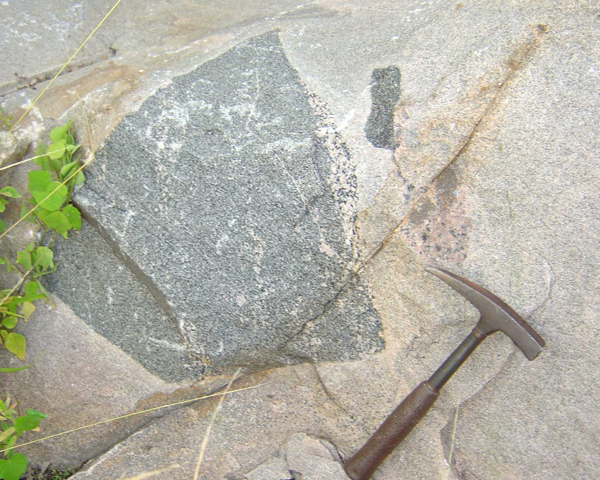
Gabbroic enclaves and features of magma mingling and mixing in the bimodal, alkaline, anorogenic, granitic intrusion of Salto da Divisa (Araçuaí Orogen). The magmatic crystallization age obtaining from zircon U-Pb SHRIMP analysis is ca. 880 Ma (Silva et al. 2002b).
Plate 2. The Salto da Divisa granite
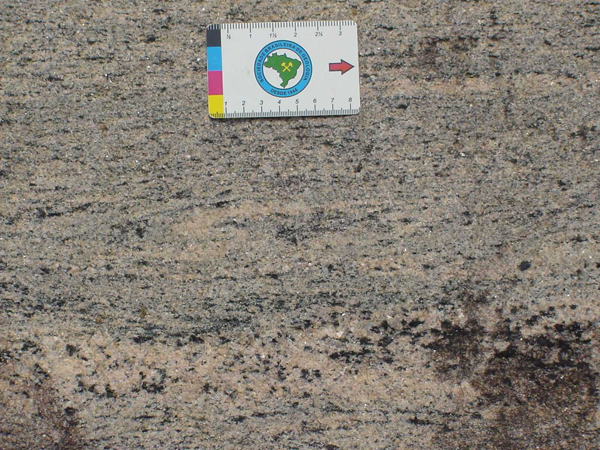
The Salto da Divisa granite, as well as its mafic enclaves, becomes strongly deformed toward the tectonic contact of the intrusion. This photo shows the Brasiliano solid state foliation and folded veins rich in quartz and K-feldspar (Araçuaí Orogen). Both the foliated and less deformed granitic facies are fluorite-bearing rocks (Paixão and Perrella 2004).
The sedimentary fill of the basin starts with the proximal units of the Macaúbas Group that are metamorphosed in the greenschist facies. U-Pb data of detrital zircons suggests a maximum sedimentation age for this unit around ca. 900 Ma. The lower and proximal facies of this group, such as quartz arenites and conglomerates, superposed by diamictites (Plate 3) with intercalations of quartz arenites are interpreted to represent the rift stage. The transitional stage from rift to passive margin is represented by the glacio-marine sequence of the Macaúbas Group, well preserved north of Diamantina (Figure 4). This sequence consists of diamictite (debris flows) with intercalations of arenitic to pelitic turbidites (Plate 4) and sedimentary iron formation (Rapitan type, Plate 5).
Plate 3. Massive diamictite metamorphosed in the low greenschist facies
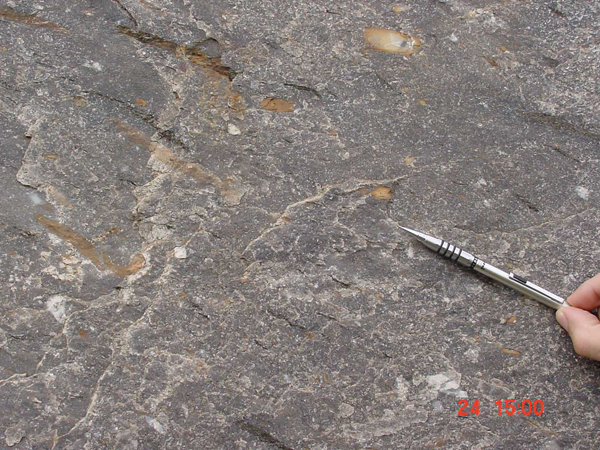
Massive diamictite metamorphosed in the low greenschist facies, showing stretched clasts of limestone (brown), quartz and quartzite (light colored) and schist (dark gray), in the graywacke matrix (Serra do Catuni Formation, a proximal glaciogenic formation of the Macaúbas Group; quarry close to Couto Magalhães town, Araçuaí Orogen).
Plate 4. Debris flows (diamictite layers) and sandy turbidites (quartzite layers)
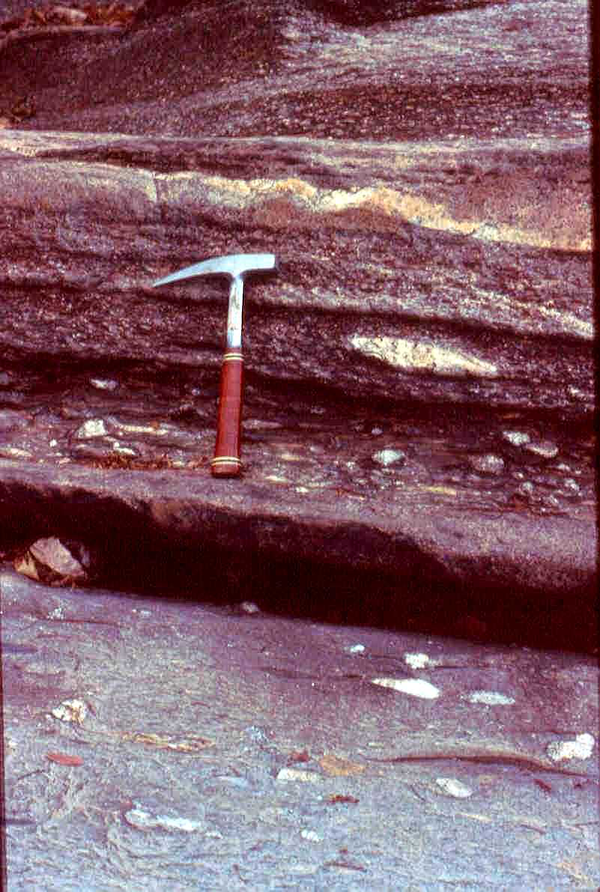
Debris flows (diamictite layers) and sandy turbidites (quartzite layers), showing finning up graded bedding, of the glacio-marine sequence of the Macaúbas Group, Chapada Acauã Formation, outcrop in the Araçuaí River to the west of Turmalina town). The rocks are deformed and metamorphosed in the high greenschist facies.
Plate 5. Sedimentary iron formation composed of hematite-rich bands
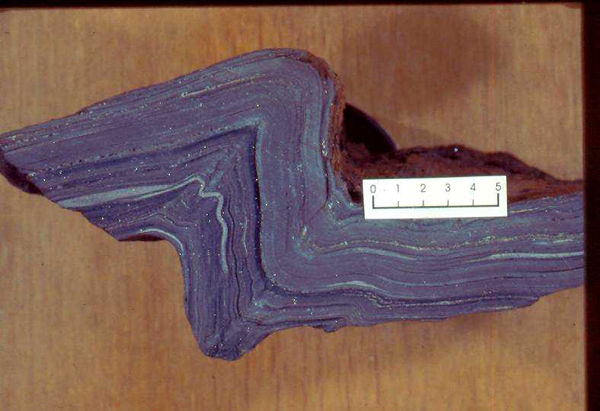
Sedimentary iron formation composed of hematite-rich bands and thin quartz-rich bands, with disseminated clasts, metamorphosed in the greenschist facies, of the glacio-marine sequence Nova Aurora Formation, Macaúbas Group, Araçuaí Orogen.
The passive margin stage of the Macaúbas Basin is represented by extensive deep-sea turbidites and by remnants of oceanic crust. This distal unit of the Macaúbas Group is the Ribeirão da Folha Formation (Figure 4). The sedimentary part of the formation is transformed into a banded quartz-mica schist with intercalations of calc-silicate rock, graphite schist and marble. The volcano-sedimentary part is now a peraluminous micaschist (Plate 6) with intercalations of sulphide-rich metachert, graphite schist with kyanite, banded iron formation of oxide (Plate 7), silicate (Plate 8) or sulphide type, and ortho-amphibolites. The Ribeirão da Folha Formation records the garnet, staurolite, kyanite and sillimanite zones, of the intermediate pressure regional metamorphism. The Dom Silvério Group also includes deep-sea sedimentation associated with ocean-floor magmatism and has been correlated to the Ribeirão da Folha Formation.
Plate 6. Folded peraluminous schist
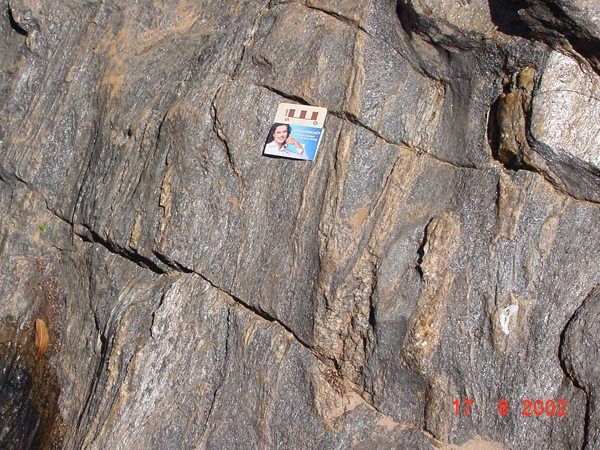
Folded peraluminous schist consisting of quartz, biotite, muscovite, garnet, kyanite, staurolite and minor K-feldspar and plagioclase, with kyanite-bearing quartz veins, of the Neoproterozoic, oceanic, volcano-sedimentary sequence Ribeirão da Folha Formation, Macaúbas Group, Araçuaí Orogen.
Plate 7. Oxide-type banded iron formation
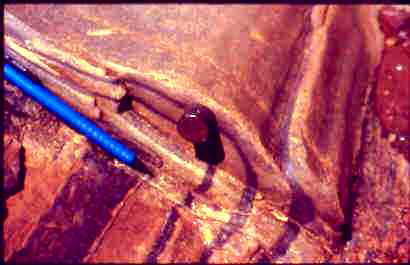
Oxide-type banded iron formation rich in magnetite (black bands) of the Neoproterozoic, oceanic, volcano-sedimentary sequence Ribeirão da Folha Formation, Macaúbas Group, Araçuaí Orogen.
Plate 8. Silicate-type banded iron formation
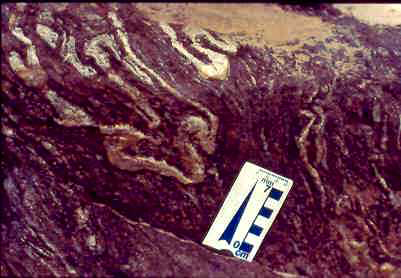
Silicate-type banded iron formation rich in garnet and amphiboles (reddish dark bands) of the Neoproterozoic, oceanic, volcano-sedimentary sequence Ribeirão da Folha Formation, Macaúbas Group, Araçuaí Orogen.
The ortho-amphibolites associated to the Ribeirão da Folha Formation have geochemical signature of ocean floor and represent diverse parts of oceanic crust, from the lower gabbroic portions (Plate 9) to the upper volcanic rocks. Sm-Nd whole rock dating of these rocks yielded an isochron indicating an age of around 816 Ma ( Nd(800 Ma) = + 4.6), interpreted as the magmatic crystalization age. Tectonic slices of ultramafic rocks are also associated with the Ribeirão da Folha Formation. They consist predominantly of tremolite-anthophyllite schist with magmatic chromite, and some nucleii of peridotite (Plate 10). Sm-Nd data suggest that the ultramafic rocks are contemporaneous with the ortho-amphibolites.
Plate 9. Coarse-grained ortho-amphibolite
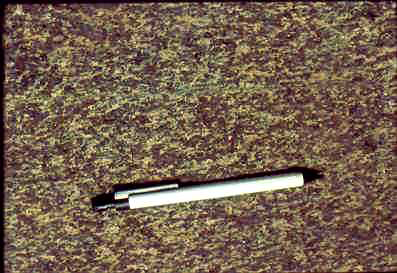
Coarse-grained ortho-amphibolite consisting mainly of plagioclase, hornblende and clinopyroxene, interpreted as a massive gabbro of the ophiolite section (outcrop close to Ribeirão da Folha village, Araçuaí Orogen).
Plate 10. Meta-ultramafic rock
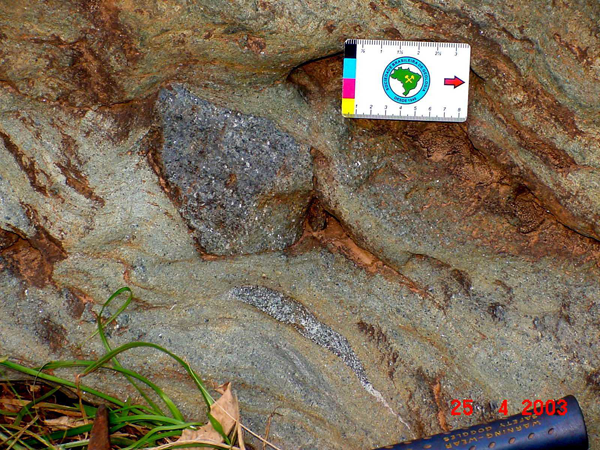
Meta-ultramafic rock of a tectonic slice thrust over the oceanic volcano-sedimentary sequence. The light-colored matrix consists of tremolite schist. The dark-colored stretched "fragments" (xenoliths?) are also rich in amphiboles with disseminated magmatic chromite (outcrop close to Ribeirão da Folha village, Araçuaí Orogen).
The Capelinha Formation consists of an arenitic sequence with minor banded iron formation and pelite, metamorphosed in the amphibolite facies. This formation overlies the Ribeirão da Folha Formation, in the distal part of the Macaúbas Group.
The Rio Doce Group, located to the east of the Macaúbas Group (Figure 4) is intruded by pre-collisional granites and is composed by deep marine turbiditic sediments (metagreywacke, micaschist and banded gneiss). This group may well represent the eastern margin of the basin (i.e., the "African" side; Figure 4 and Figure 5).
Figure 5. NW-SE cross-section along the central region of the Araçuaí Orogen

NW-SE cross-section along the central region of the Araçuaí Orogen (A-B in Fig. 4). 1- cratonic cover (Bambuí Group); 2- proximal units of the Macaúbas Group; 3- Ribeirão da Folha Formation; 4- tectonic slices of ultramafic rocks thrust onto the oceanic rock assemblage of the Ribeirão da Folha Formation; 5- suture zone; 6- calc-alkaline magmatic arc represented by the G1 Suite; 7- G5 Suite; 8- G2 and G3 suites (S-type anatexis zone); 9- paragneiss complex.
The Brasiliano Orogeny in the Araçuaí Orogen can be subdivided into the following stages: pre-collisional (ca. 630-585 Ma), syn-collisional (ca. 585-560 Ma), late collisional (ca. 560-535 Ma) and post-collisional (ca. 520-490 Ma). These time periods are defined based on U-Pb ages obtained on zircon, monazite and sphene, published in the literature cited above and references therein.
The pre-collisional or accretionary (ca. 630-585 Ma) is mainly represented by the construction of a calc-alkaline magmatic arc (Figure 4 and 5). In this stage a suite of intrusive igneous rocks, called G1, was generated. It is composed predominantly of tonalites and granodiorites, with few diorites and numerous mafic enclaves (Plate 11). The regional foliation is present in this suite as well as in the enclaves. A large number of geochemical data is consistent with the formation of this suite in a tectonic environment of a magmatic arc in an active continental margin. Sm-Nd and Rb-Sr isotope data suggest a hybrid source Martins et al. (2004), both from the mantle and the crust, but with the major contribution from the latter. The limits of this magmatic arc and the distribution of the oceanic remnants suggest that the suture zone is located roughly along the 42 W meridian, south of latitude 17 S (Figure 4 and 5), and that the subduction was to the east (present coordinates).
The sedimentation of part of the sediments that were later converted to paragneisses took place in the time interval from the pre-collisional to the syn-collisional stage, as suggested by U-Pb ages of detrital zircons (Noce et al., 2004). The Sm-Nd model ages suggest a mixture of Paleoproterozoic and Neoproterozoic sources. The paragneisses are mainly peraluminous, rich in biotite, garnet, cordierite and/or sillimanite, with traces of graphite (kinzigite s.s., Plate 12). Less aluminous varieties include graphite gneiss, quartzite, calc-silicate rock and a hololeucocratic granulite (leptinite). Large deposits of flake graphite are present in the northern part of the paragneiss complex.
Plate 11. Banded orthogneiss of tonalitic and granodioritic composition
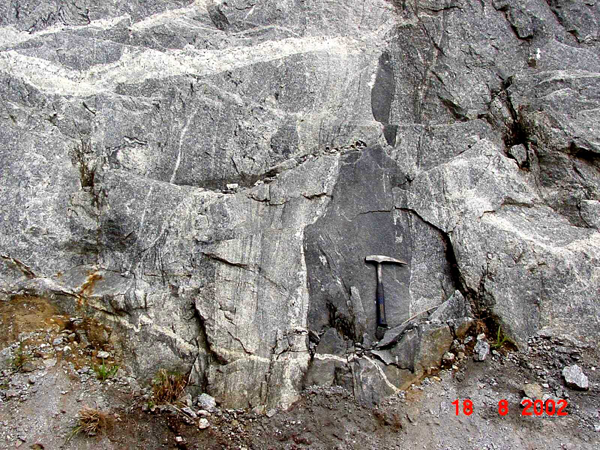
Banded orthogneiss of tonalitic and granodioritic composition with stretched mafic enclaves (G1 suite, Bairro Palmeiras quarry, Teófilo Otoni town, Araçuaí Orogen).
Plate 12. Peraluminous paragneiss
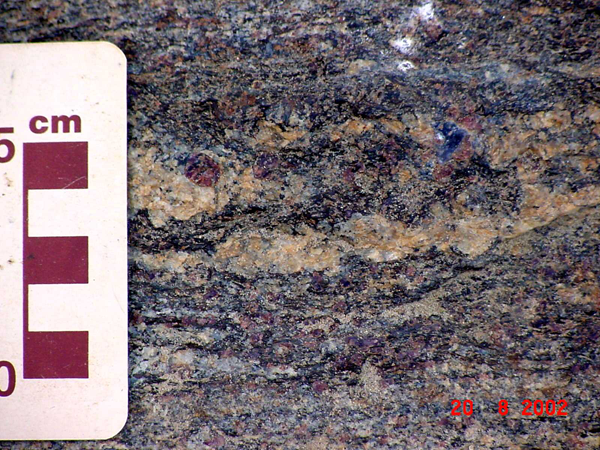
Peraluminous paragneiss (kinzigite) rich in red almandine and blue cordierite (outcrop ca. 20 km west of Salto da Divisa town, Araçuaí Orogen).
The principal deformation and metamorphism took place in this stage (ca. 585-560 Ma). The directions of increasing metamorphic temperature converge to the zone of intense anatexis located in the internal tectonic domain of the orogen (Figure 4). The regional foliation in pelitic rocks of the Macaúbas Group, in the external tectonic domain, is formed by mineral associations that define an intermediate pressure facies series, from chlorite zone to kyanite zone. In the internal domain, associations with biotite, garnet, cordierite and/or sillimanite, syn-kinematic to the regional foliation of pelitic schists and gneisses, are indicative of regional metamorphism reaching high amphibolite facies with relatively low to medium pressures.
Foliated S-type granites (granite gneisses, Plate 13, Nalini Jr. and Billal 2000) of this stage are labelled as G2 suite. This suite includes in situ bodies and intrusions, all deformed to lenticular shapes parallel to the regional foliation. Predominant compositions are cordierite-garnet-biotite granite, garnet-biotite granite and biotite-muscovite granite. Xenoliths and roof pendants of metasedimentary rocks in several stages of assimilation and of variable size are very common. Pegmatites rich in gemstones and industrial minerals of the region east of Governador Valadares are related to granites of the G2 suite.
Plate 13. S-type, foliated cordierite-garnet granite
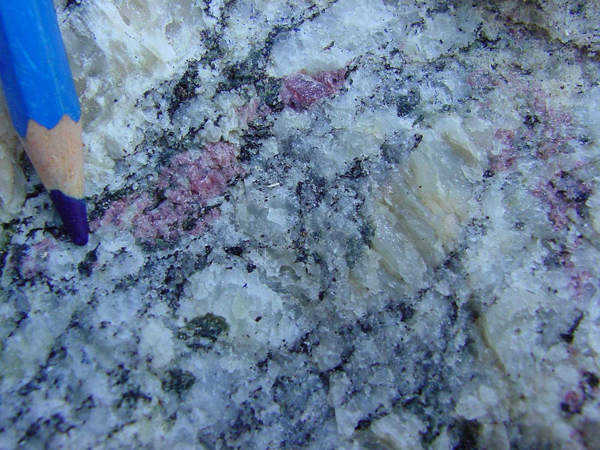
S-type, foliated cordierite-garnet granite of the syn-collisional G2 suite (outcrop close to Nanuque town, Araçuaí Orogen). This sample yielded an age of ca. 575 Ma (zircon, U-Pb SHRIMP; Silva et al., 2002).
The late collisional stage apparently lasted from ca. 560 until 535 Ma. However, these time limits are imprecise due to the scarcity of conclusive geochronological data. It is represented by S-type granites, with ages within this interval. An older group of granites, with relatively strong foliation, coherent with the regional foliation, were included in the G2 suite, while the youngest group, with weaker or without foliation, was grouped in the G3 suite. This is a tentative subdivision as the partitioning of strain and depth of erosion may also result on different structures of the granitoid rocks.
The most characteristic granite of the G3 suite is a garnet-cordierite leucogranite (Plate 14). The suite includes mainly felsic peraluminous residues, but also veins and small plutons. Field relationships and the composition of some residues suggest a derivation by partial melting of the country rocks during the late collisional stage.
Plate 14. Cordierite-garnet leucogranite of the G3 suite
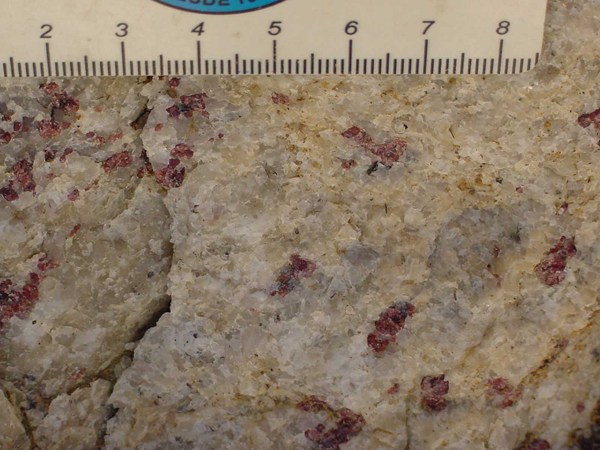
Cordierite-garnet leucogranite of the G3 suite (outcrop close to Nanuque town, Araçuaí Orogen).
The late orogenic sedimentation is represented by the deposition of the Salinas Formation (Figure 4, Plate 15). In its type area this formation consists of graywacke, pelite and clast-supported conglomerate, metamorphosed to greenschist facies. U-Pb SHRIMP data of detrital zircons and zircons from felsic volcanic pebbles suggest a maximum age for deposition at ca. 570 Ma. A minimum age is established by ca. 500 Ma granitic intrusions related to the G4 suite.
Plate 15. Banded graywacke of the Salinas Formation
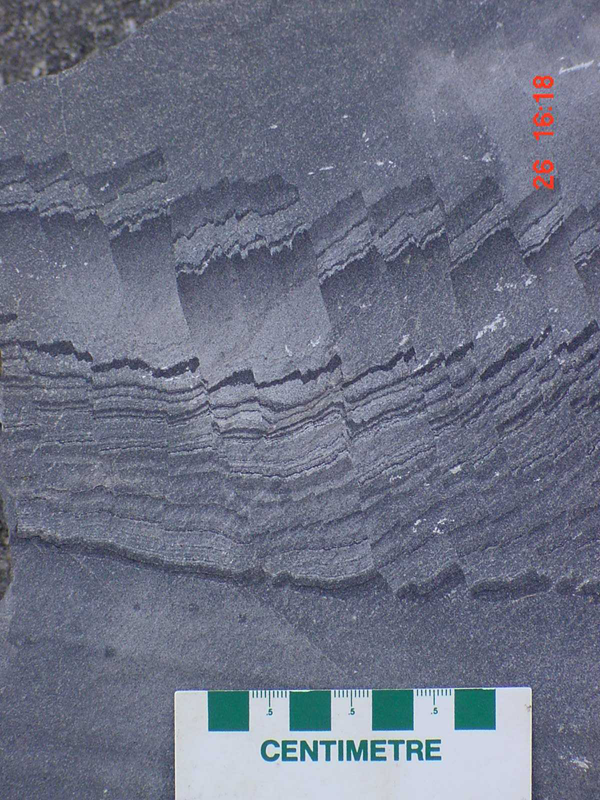
Banded graywacke of the Salinas Formation (roadcut of the BR-251 highway, ca. 25 km to the west of Salinas town, Araçuaí Orogen). The light-coloured bands are rich in the sand fraction and the dark ones are rich in biotite (i.e., argillaceous material), displaying a fining-up graded bedding.
The post-collisional stage (ca. 520-490 Ma) shows striking evidence for extensional collapse of the Araçuaí Orogen. In the external tectonic domain a steeply west-dipping crenulation cleavage and normal faults are the principal structures generated in upper crust level, during this stage.
The G4 and G5 granitic suites are associated with this stage (Figure 4). G4 granites crop out along the boundary between the external and internal tectonic domains and are composed of relatively shallow (5 to 15 km depth) intrusions (Campos et al., this volume). They have circular surface shapes and may form clusters of amalgamated plutons with pegmatoid roofs locally preserved. G4 granites are S-type and present variable proportions of biotite, muscovite and garnet. They contain abundant xenoliths and may show igneous flow patterns. Plutons rich in mica show locally a west dipping foliation, parallel to the crenulation cleavage related to extension. G4 granites are sources of residual pegmatites, rich in gemstones (particularly tourmaline and morganite), lithium minerals, feldspars and minerals interesting to the ceramics and glass industry, apart from rare metallic minerals like tantalite.
The G5 suite is composed of I-type granites without regional foliation, limited to the internal tectonic domain of the orogen. They contain locally charnockitic and enderbitic portions. In the southern part of the orogen, where deeper parts of the crust are exposed, zoned plutons with mafic cores are common. The composition of G5 plutons varies from gabbros to syenogranites. The granitic rocks are generally porphyritic to sub-porphyritic and contain abundant mafic enclaves and also xenoliths (Wiedemann, 1989, 1993). Features of mingling and mixing of magmas are common (Plate 16). The chemical composition is calc-alkaline with high K and high Fe contents. G5 plutons, particularly the ones in the north of the orogen, are sources of pegmatites rich in aquamarine and topaz. For a more detailed description of the suites G1 to G5, including a field guide, see de Campos et al. (this volume).
Plate 16. Enclaves indicating magma mingling and mixing
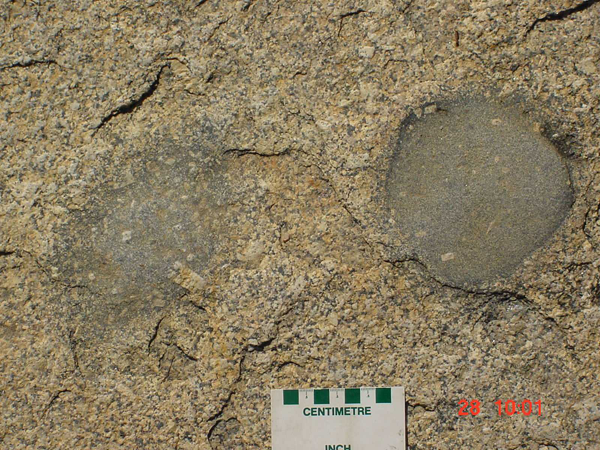
Enclaves indicating magma mingling and mixing in a post-collisional, high-K calc-alkaline G5 granite (outcrop ca. 3 km south of Medina town, Araçuaí Orogen).
Paleogeographic reconstructions suggest that the São Francisco and Congo cratons remained partially united since ca. 2 Ga until the opening of the South Atlantic at the end of the Jurassic. This cratonic link that united Bahia State in Brazil with Gabon in Africa limited the opening of the precursor basin of the Araçuaí-West Congo Orogen. For this reason the basin would have been essentially a large gulf, connected to the north with the Paramirim and Sangha aulacogens (Figure 2). This gulf would have remained ensialic north of parallel 17 S, but to the south of this parallel limited ocean opening would have occurred. Towards the south the gulf would have opened to an extensive ocean, the closure of which resulted in the Ribeira Orogen and other branches of the Brasiliano-Pan-African orogenic system.
The Araçuaí Orogen, as a result of the closure of a gulf, is therefore characterised as a confined orogen. The mechanism to close this type of orogen is problematic because of the mechanical limitations imposed by the cratonic link and by the limited and relatively hot and buoyant oceanic lithosphere that would not start subduction by its own. A possible solution to this problem is that closure was forced by other collisions of the Amazonian, Rio de la Plata and Paranapanema-Paraná paleocontinents against the western side of the São Francisco paleocontinent, according to a model proposed by Alkmim et al. (2003).